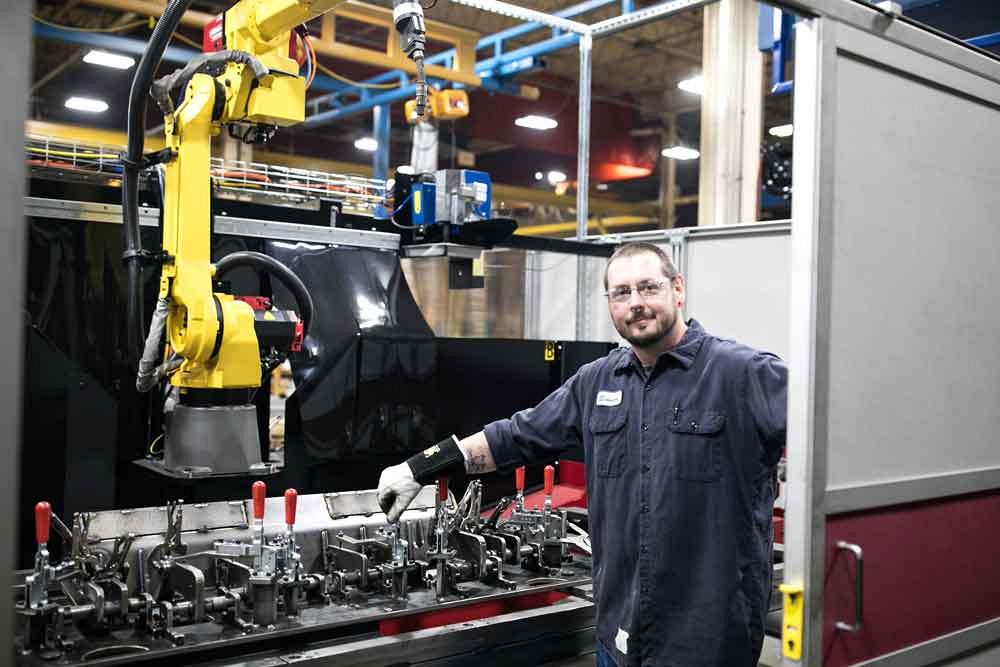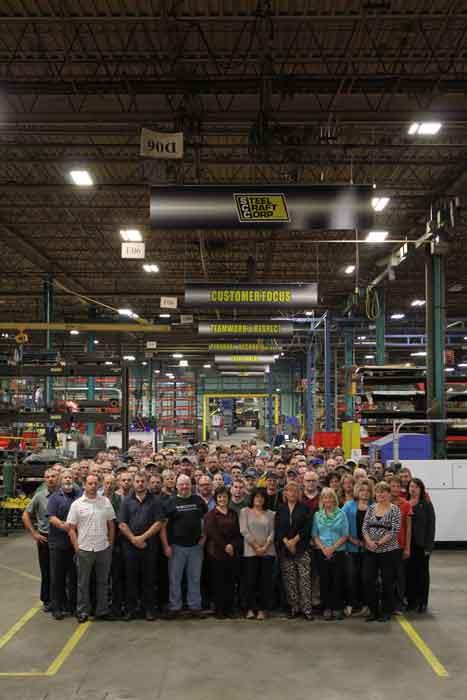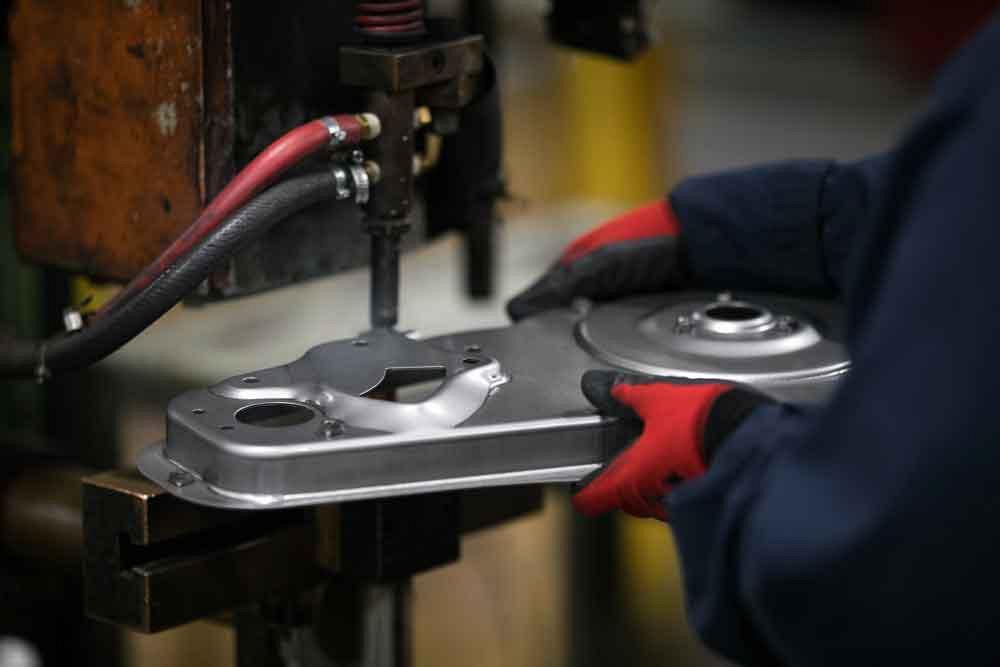Senior Editor
- FMA
- The Fabricator
- FABTECH
- Canadian Metalworking
Categories
- Additive Manufacturing
- Aluminum Welding
- Arc Welding
- Assembly and Joining
- Automation and Robotics
- Bending and Forming
- Consumables
- Cutting and Weld Prep
- Electric Vehicles
- En Español
- Finishing
- Hydroforming
- Laser Cutting
- Laser Welding
- Machining
- Manufacturing Software
- Materials Handling
- Metals/Materials
- Oxyfuel Cutting
- Plasma Cutting
- Power Tools
- Punching and Other Holemaking
- Roll Forming
- Safety
- Sawing
- Shearing
- Shop Management
- Testing and Measuring
- Tube and Pipe Fabrication
- Tube and Pipe Production
- Waterjet Cutting
Industry Directory
Webcasts
Podcasts
FAB 40
Advertise
Subscribe
Account Login
Search
Diverse fabricator and stamper goes to market under one brand umbrella
Steel Craft Corp. has a history involving three metal manufacturing divisions, each with its own niche
- By Tim Heston
- June 25, 2020
- Article
- Shop Management

Wisconsin metal manufacturer and 2020 FAB 40 member Steel Craft Corp. has a history involving three companies, each with its own niche: fabricating, stamping, and finishing. They’re stronger together. Images provided by Steel Craft Corp.
The FAB 40, a statistical slice of U.S. custom and contract metal fabrication, has revealed just how important mergers and acquisitions have been to the growth equation. Organic growth remains significant, though. The economic turmoil of 2020 will no doubt break the growth trend. But between 2015 and 2019, many longtime FAB 40 participants showed double-digit year-over-year revenue growth with no company acquisitions whatsoever, even though they were many years into the last economic recovery cycle. Still, the truly dramatic revenue jumps happen after a company purchase, and outside investors like private equity are increasingly becoming part of the story.
Metal manufacturers in different but complementary niches are being rolled up under one umbrella, and a brand transition is underway. Familiar to longtime customers, the legacy company brands remain. But increasingly these organizations are targeting new customers and markets under a single, one-stop-shop name.
Steel Craft Corp.’s story fits this narrative. The organization is following a strategy that goes back to the business fundamentals of custom metal manufacturing: diversification, both in processing capability and customer base; customer collaboration; and a healthy dose of inventory control and cash flow management.
Diversification Efforts
The Hartford, Wis., metal manufacturer had been owned by the Wendorff family since 1976, growing over the decades as a welding and custom metal fabrication job shop. The family launched Hartford Finishing Inc. in 1983 and in 2005 purchased Milwaukee-based Capitol Stampings through a receivership.
Bringing any business through a receivership requires change, of course, and the turnaround at Capitol Stampings involved plenty. “We first focused on diversifying the business,” said COO Gary Wenzel, who helped spearhead the Capitol Stampings turnaround. “The company was very dependent on lawn and garden. We had all these press assets, and we needed to fill them with non-lawn and garden business, so the assets could stay busy all year.”
Capitol took a two-pronged approach to diversification. First, it diversified its customer base beyond the lawn and garden sector. “Today we’re about 50% lawn and garden, 50% other markets,” Wenzel said, “so we’re busy throughout the year.”
Second, the company diversified within the lawn and garden sector itself. Previously it had served mainly the residential side of the sector. Over the years, Wenzel and his team worked to expand Capitol’s presence on the commercial side as well.
“Gary was really a critical part of that success story,” said Tom Verbos, Steel Craft president and CEO. “He was really key to bringing [Capitol Stampings] into the [Wendorff] family and turning it from a defunct business into a successful segment of the overall portfolio.”
Lean Cells, Changeovers, and Inventory
By the late 2010s brothers Gary and Gene Wendorff were looking to step back from the business, and in 2019 they did just that, selling Steel Craft, Capitol Stampings, and Hartford Finishing to Lexington, Ky.-based MiddleGround Capital, a private equity firm founded by former Toyota managers and engineers. All three companies now are branded as divisions operating under the Steel Craft Corp. umbrella.
MiddleGround managers come from the Toyota Production System world. Being a custom and contract manufacturer, Steel Craft operates in a different arena, but of course some elements of TPS and lean manufacturing apply. It’s all about adding value (to sheet metal and plate, in this case) effectively and quickly, always with an eye on that quote to-cash cycle: the time between financing an order (like paying for the material) and shipping and getting paid for that order. A manufacturer can’t make payroll with inventory—so, of course, inventory must be controlled.

Before social distancing requirements imposed by COVID-19, some of Steel Craft Corp. employees gather at the company’s plant in Hartford, Wis. The company’s three operating divisions employ more than 600 workers.
“The name of the game is generating cash and turning working capital.”
So said CFO Ken Daiss, who came from Defiance Metal Products (now owned by MEC). He joined Steel Craft in October 2019, and earlier this year he spearheaded an aggressive inventory reduction process based less on past demand and more on what’s ahead—the order book.
“In the Capitol Stampings side of the business, we’ve had our highest inventory turns in the history of the company,” Wenzel said. “I don’t think that happened by accident.”
“We approached [inventory reduction] by bringing together every functional team within the company,” Daiss said, “from [top management] and the sales team to scheduling, planning, and customer service. And it couldn’t have happened at a better time.”
Daiss was, of course, referring to the economic crisis spurred by COVID-19. The inventory control measures weren’t put in place because of the crisis; they just happened to occur at a very opportune time.
As Daiss explained, “At Capitol [Stampings], when we saw demand start to soften quickly, we touched base with our suppliers to cut off incoming supply as quickly as possible, so we could better align with demand.”
Steel Craft’s business isn’t down across the board, which is more evidence of how well the “better together” strategy works in custom metal manufacturing. Capitol Stampings has taken the hardest hit, but Steel Craft’s custom fabrication business has held its own. As Verbos explained, “We’re actively engaged in making hospital bed products. And from a coating perspective, we’re engaged not only in medical bed products but hand sanitizer dispensary products. We’re also providing coating and assembly services for respirator products.”
The inventory management process helped prevent lagging sales in the stamping division from draining cash. Of course, inventory control on its own wouldn’t have been effective without another critical part of the lean toolbox: streamlined changeovers. “Running in parallel [to inventory control] has been our setup reduction efforts,” Wenzel said. “You can’t have hourslong die setups and expect not to hold inventory. Our setup and [lean] boot camps occurred well before our inventory control initiative. These two critical processes working in tandem results in good outcomes.”
These boot camps began last year not long after the MiddleGround acquisition. “We now have weekly and monthly continuous improvement events that continue to drive efficiencies throughout the business,” Verbos said.
The company’s heavy tank fabrication cell is a prime example. Customized to order, the tanks are produced within a dedicated cell that has all the cutting, forming, and positioning equipment required for single-piece part flow.

Steel Craft Corp. is all about adding value (to sheet metal and plate, in this case) effectively and quickly, always with an eye on that quote to-cash cycle: the time between financing an order (like paying for the material) and shipping and getting paid for that order.
“We cut that product as a kit, move it, form it, tack it, rotate it, finish-weld it, test it, and ship it out,” Verbos said. The finished products can be nearly 5,000 lbs., and the cell can produce between 15 and 20 a day. “And we can engineer, launch, and ship these products within a two- to three-week period.”
During the past six months, the company has streamlined its new product introductions (NPI) process, involving close customer collaborations and utilizing interactive calls and (before the pandemic) plant visits. These started with the fabricator being brought in early to collaborate on design-for-manufacturability efforts.
Customers saw the prototype fabrication, then revisited several weeks later after a boot camp or two. “We’ve shown them improvements we’ve made as we transition from prototype to production,” said Kelly Wendorff, vice president and general manager. “The output of that cell, even just two weeks later, shows an incredible contrast. We see improvements in productivity, quality, and customer satisfaction.”
On its website Steel Craft publishes an equation that probably hits home for many in custom metal manufacturing: Voice of the customer + Collaboration + NPI launch = Delivered value. Years ago the late Dick Kallage, a longtime industry consultant and columnist for this magazine, described just how important that first factor, the voice of the customer, really is.
“Why do companies buy from you?” he asked. “Believe it or not, most can’t answer this fundamental question. Not knowing why customers buy from you makes future performance much riskier. So how do you find out why customers buy from you? Ask them, and ask them often, at many levels and in many forms. Listen to the voice of the customer.”
In Steel Craft’s case, the voice of the customer could be seen as part of a virtuous cycle that drives upfront collaboration, NPIs, and ultimately production.
This cycle, Verbos said, has driven company growth. “Even prior to the acquisition from MiddleGround, the company was on a very strong growth path. Over the past few years our volume has doubled, and we’ve done it by strategically managing and prioritizing our business. And we see those volumes doubling again within the next three to five years.”
Verbos made those comments in April, and he and other executives conceded that, of course, COVID-19 will affect revenue in the near term. But because of its position—including customer diversification, its inventory management efforts, and overall collaborative approach—Steel Craft Corp.’s long-term outlook hasn’t changed.About the Author

Tim Heston
2135 Point Blvd
Elgin, IL 60123
815-381-1314
Tim Heston, The Fabricator's senior editor, has covered the metal fabrication industry since 1998, starting his career at the American Welding Society's Welding Journal. Since then he has covered the full range of metal fabrication processes, from stamping, bending, and cutting to grinding and polishing. He joined The Fabricator's staff in October 2007.
subscribe now

The Fabricator is North America's leading magazine for the metal forming and fabricating industry. The magazine delivers the news, technical articles, and case histories that enable fabricators to do their jobs more efficiently. The Fabricator has served the industry since 1970.
start your free subscription- Stay connected from anywhere

Easily access valuable industry resources now with full access to the digital edition of The Fabricator.

Easily access valuable industry resources now with full access to the digital edition of The Welder.

Easily access valuable industry resources now with full access to the digital edition of The Tube and Pipe Journal.
- Podcasting
- Podcast:
- The Fabricator Podcast
- Published:
- 04/16/2024
- Running Time:
- 63:29
In this episode of The Fabricator Podcast, Caleb Chamberlain, co-founder and CEO of OSH Cut, discusses his company’s...
- Trending Articles
Tips for creating sheet metal tubes with perforations

JM Steel triples capacity for solar energy projects at Pennsylvania facility

Are two heads better than one in fiber laser cutting?

Supporting the metal fabricating industry through FMA

Omco Solar opens second Alabama manufacturing facility

- Industry Events
16th Annual Safety Conference
- April 30 - May 1, 2024
- Elgin,
Pipe and Tube Conference
- May 21 - 22, 2024
- Omaha, NE
World-Class Roll Forming Workshop
- June 5 - 6, 2024
- Louisville, KY
Advanced Laser Application Workshop
- June 25 - 27, 2024
- Novi, MI


























